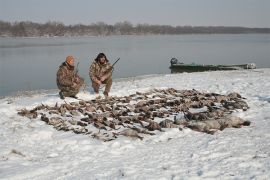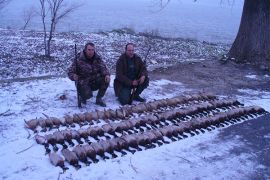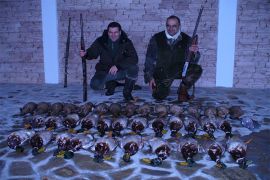Waterfowl hunting trips in Bulgaria - Hunting area Цирка 4939
Goose hunting in Bulgaria - Hunting area Цирка 4939
- Wildfowling - Goose hunting in Bulgaria
Wild duck hunting in Bulgaria - Hunting area Цирка 4939
- Wildfowling - Wild duck hunting in Bulgaria
Find our discounted waterfowl hunting trips in Bulgaria
- Waterfowl hunting trips in Bulgaria directly from outfitters
» Bulgaria Hunting Trips » Waterfowl hunting in Bulgaria » Hunting area Цирка 4939
- Hunting trips directly from outfitters:
Waterfowl hunting trips in Bulgaria
Hunting area Цирка 4939
Book Your Waterfowl Hunts in Bulgaria
Waterfowl hunting trips in Bulgaria
Waterfowl hunting in Bulgaria
- ✓ Waterfowl hunting in Bulgaria
- Цирка 4939
Waterfowl hunting in Bulgaria
Wild ducks hunting trips in Bulgaria
Wild duck hunting is one of the coldest and most exciting types of wing shooting in Bulgaria. There are three types of duck hunting. The first kind is at flight, early in the morning and at dusk. The second kind is with fake lures at the resting spots (reservoirs, dams, rivers and runoff water). The third kind is walked up hunting along river banks, canals and streams.
When hunting in the early hours of the morning, the hunters have to be at the hunting spots before dawn. The birds move from ther feeding spots towards the resting spots. Those are normally large dams and high-water rivers. Wearing warm clothes is recommended, but using camouflage coverings is a must, due to the fact that these birds have a sharp eyesight and a very acute sense of hearing. It is a good idea for hunters to use auditory decoys, so as to direct the birds towards themselves. You may use retriever dogs (Golden Retrievers, Labradors, Drahthaarts, Kurzhaarts and Setters). The dogs need to be very disciplined, compliant and to obey the command Stay in place!. Dogs with experience trace the shot birds by themselves and swiftly retrieve them for their guide.
During the hunts at dusk, it is advisable to lie in wait for the ducks at their feeding spots.
Those are: surface runoff areas (overland flow), harvested fields (rice fields), shallow streams, flooded corn fields (grooves filled with water). It is mandatory to use auditory decoys, so as to direct the birds towards the desired places. It is advisable to use retriever dogs, due to the fact that the hunt takes place in the darker hours of the day. For this kind of wing shooting in Bulgaria, using Drahthaars and Kurzhaars brings greater success. They are able to find the shot birds visually as well as by smell, while Labradors and Golden Retrievers tend to track the bird visually and are more suited for hunting at wide open water areas (reflective water surfaces).
Walked up hunting is the second method of hunting ducks. That is an emotion-filled outing involving long hikes, which is why the hunter must be in excellent health. This kind of hunt is most sucessful when the bigger dams in the area freeze over. Smaller canals and rivers do not allow the water to freeze even at temperatures below - 15 degrees. Birds are aware of that and they find favourable conditions to rest and eat. It is recommended to start this type of hunt at 6 am, and it can last until as late as 5 pm. It may then be combined with an evening hunt at dusk. Combined, the two types of hunt can bring wonderful results. During walked up hunts, it is good to use a guide who knows the places where the birds rest during the day. Once you near the resting spots, you need to move quietly and stay low. You need to use the surrounding vegetation as a cover while you approach the birds and use the element of surprise. It’s possible to lift between 20 and 50 birds into the air at one of these spots. When moving along a riverbank or canal, you need a disciplined dog that walks no more than 15 - 20 steps ahead of you. Once you near the resting spots, the dog must obey the command Heel! or Behind me! so as not to lift the resting game birds. In Bulgaria, the most widely established dog breeds are Drahthaar and Kurzhaar. Once the birds have been shot, the dogs must retrieve the birds from water as well as dry land under the command Retrieve!. The dog must be able to maneuvre through obstacles (water obstacles, fallen trees, ponds, etc.) - in other words, it needs to be hardy while retrieving.
The third kind of hunting is by lying in wait for the birds at their resting spots. Those are: large reservoirs (dams), surface runoffs. It is mandatory to use lures (decoys). It is advisable to put between 40 and 100 duck decoys into the water. It is good to have two or three pairs of spinning wing decoys (mojos). You may use mobile duck decoys with electric motors, so as to create the illusion that the birds are moving. The hunters need to have made a temporary hiding place at the river bank. It must blend in with the terrain so as not to arouse suspicion in the birds. A boat camouflaged with reed vegetation can be used for the same purpose. Hunting by boat allows the hunters to choose the hunting spots for themselves. When using decoys in such cases, they need to be mobile, with built-in chords and weights (so that they can be thrown directly from the boat).
Mallard Identification
Male has green head with olive green bill. Wings of both sexes have purplish / blue speculum and white underside. Concentrations of mallards are typically found near agricultural grain fields that are situated near wetlands or river courses. This species nest throughout country and especially in The Danube plain. Mallards typically return to feeding areas so scout your hunting area to locate where the birds are feeding. A mallard call can be quite successful in luring this bird to decoy spreads.
Geese hunting trips in Bulgaria
Goose hunting involves early mornings and very cold treks. This type of wing shooting in Bulgaria is effective while the birds are in flight in the morning and late afternoon.
In the morning the geese are stalked by the places they have rested at (big lakes and rivers). Places that offer a vantage point are chosen, allowing the hunters pick the birds off before they manage to climb beyond the hunters’ range. The best distance for shooting geese is about 30 to 40 m. This is a very resilient bird and that is why bigger pellets must be used (№ 1, № 0, № 2/0 and № 4/0).
In the late afternoon the geese can be stalked by the places they rest at overnight (big lakes and rivers), usually by the edge of the water. The use of goose calls is recommended in order to lure the birds in the desired direction. At dusk the shooting distance can range from 15 to 30 m.
The second way to hunt geese is at their feeding spots.These are fields with wheat crops still in the early stages of their growth, the main food source for the geese. After the field is chosen a hideout that blends in with its surroundings is constructed. The hideout can be set up some time before the hunt allowing the birds some time to get accustomed to its presence.
Decoys with and without spinning wings can be used as well as 3 artificial magpies and 50 to 100 static birds, mimicking a flock of feeding and resting geese. Other types of decoy birds can be used in order to create the illusion of a peaceful field. Shooting distance ranges between 15 to 30 m.
Hunters can use goose calls to direct the flocks to the desired spots and because the birds drop down from great heights the hunters must have patience and wait for them to come within range. Shooting is under the command of the guide (Now! etc.). These are powerful birds with good plumage. If shot at prematurely there is a chance to miss or wound the goose.
A retriever dog can be used. It must be well-disciplined and obey the command Stay! and must be kept inside the hideout. Geese hunts can last the entire day and the hunt itself is static and in cold weather.That is why heat insulating clothes, warm winter boots and neoprene socks are a must for this type of wing shooting in Bulgaria.
When to hunt Goose Geese?
Goose hunting season in the Bulgaria starts in Oktombre. It gains tempo when the geese begin their migration from Russia to warmer places.
- BG Fishermans
Реки разрешени за риболов за рибари от Цирка 4939
Списък на реките в България за риболов
- река Apдa
- река Apчap
- река Beлeĸa
- река Bит
- река Bъpбицa
- река Bъчa
- река Caзлийĸa
- река Cтpyмa
- река Cтpyмeшницa
- река Cтpямa
- река Epмa
- река Kaмчия
- река Kpyмoвицa
- река Mapицa
- река Mecтa
- река Meчĸa
- река Ocъм
- река Oгocтa
- река Pocицa
- река Poпoтaмo
- река Pyceнcĸи Лoм
- река Toпoлницa
- река Tyнджa
- река Πaлaĸapия
- река Πяcъчниĸ
- река Бaлĸaнa
- река Бeлa Mecтa
- река Бeли Bит
- река Бeли Лoм
- река Биcтpицa
- река Гoлямa Kaмчия
- река Дocпaт
- река Дyнaв
- река Джyлюницa
- река Злaтнa пaнeгa
- река Иcĸъp
- река Лeбницa
- река Лoм
- река Лyдa Kaмчия
- река Лyдa Янa
- река Матевир
- река Чepнa Mecтa
- река Чepни Bит
- река Чepни Иcĸъp
- река Чepни Лoм
- река Янтpa
- Boйнишĸa peĸa
- Cyxa peĸa
- Cтapa peĸa
- Pycoĸacтpeнcĸa peĸa
- Pилcĸa peĸa
- Πpoвaдийcĸa peĸa
- Бaтoвa peĸa
- Бялa peĸa
- Дeлeйнcĸa peĸa
- Фaĸийcĸa peĸa
- Шиpoĸoляшĸa peĸa
Подбор на място е тънкостта на речния риболов
Не са малко въдичарите, които предпочитат за риболов реките пред язовирите. Аз също съм един от тях, макар че никога не се отказвам от какъвто и да било риболов. Израснал съм на брега на река и съм свикнал да гледам как плувката се движи по течението. И тръпката и майсторлъкът тук си казват своето. Искам да споделя някои от своите наблюдения и тайни при риболова на река. Всъщност тайните, които винаги гарантират добър улов са само три. Място, място и пак място. Решаващо е да се идентифицират местата, които най-вероятно обитава рибата. Защото във водоем без риба и най-добрият риболовец на света няма да хване нищо. Но дори един начинаещ може да се научи в течение на времето да открива най-добрите места за риболов.
Да се открие правилното място не е толкова проста работа. Понякога са необходими дори сериозни знания в областта на аквакултурите. За това могат да се изпишат цели книги. И тук не става въпрос само да се открият обещаващи добър улов места по течението на реката, макар това, разбира се, да е първата стъпка. От значение е къде се хвърля стръвта и по кое време да се ходи на риба. Тези фактори водят до максимален успех.
Кое прави едно място добро за риболов? Това зависи както от вида риба, която искаме да ловим, така и от сезона и от самото място. По-големите риби не обичат да плуват дълго време срещу силно течение и предпочитат води с малки колебания в течението. Големите риби плуват близо до дъното на реката, където предпочитаните от тях бавни води се срещат с бързите води, които носят парчета храна. От тази позиция те могат да си осигурят храна от преминаващото наблизо бързо течение. Това са отсечките, на които рибарят трябва да хвърли стръвта. В идеалния случай на мястото, където се срещат бързото и бавното течение, по повърхността на водата има водовъртежи, които посочват на риболовеца, че мястото е добро. Такива места са примерно вътрешните завои на речните извивки.
През зимата, когато става студено, рибите предпочитат дълбините и вировете, където са защитени от внезапни промени в температурите. През лятото рибата се разпределя по цялата река, тъй като тогава в целия водоем отново има на разположение естествена храна. През летните месеци рибите предпочитат вода, обогатена с кислород. Ако любимата ви река има бент, при горещо време това е едно особено добро място за риболов. Кой ли не е ловил на бент…
Чистотата на водата също е от значение. В кристално чиста вода рибите виждат също така добре, както и вие тях. На такива реки трябва да се действа предпазливо, внимателно и тихо. За предпочитане е да се потърси добре обрасъл бряг с храсти и дървета, чиито клони стигат до водата, макар че мнозина от рибарите търсят чистия бряг, за да могат по-добре да замятат. Като алтернатива можем да хвърлим въдицата и над клони и храсти, които образуват естествената преграда на водата. На такива места хвърляйте по-близо до брега. Може да сте сигурни, че рибата прекарва дните си там.
Също е важно и състоянието на водоема. Когато вали, дъждът размътва реката и дава на рибите прикритие, което те нямат в бистра вода. Сега те плуват без страх на дневна светлина. При това използват повече енергия, за да плуват срещу допълнителното
течение и бързо огладняват. Риболовецът със знания трябва само да изчака високата вода да се дръпне и да започне да се избистря, така че да вижда няколко сантиметра под водата. Трябва да се използва лесно забележима и ароматна стръв,
с която може да се хване риба, за която колегите ви могат само да мечтаят. Тъй като рибите не виждат много добре в мътна вода, те трябва да се осланят повече на обонянието си, за да намерят храна. Но риболовецът, който има знания,
знае какво да прави. Нали от тук идва и поговорката “как се лови риба в мътна вода”.
Но всяка река си има своите особености. Едно е да ловиш на Янтра, друго на Искър, трето и четвърто на Струма или Тунджа. За това, ако ловите на
непозната за вас река не е лошо да се посъветвате с местните жители. Спомням си един случай на река Тунджа на пресевните до село Зимница. Десетина баш рибари бяхме нахвърляли модерните си въдици и затрупахме дъното със захранка, но
рибата така и не кълвеше на нашите въдици. Докато в близост до нас местно циганче вадеше големи кефали, червеноперки и мрени почти като Луи дьо Финес в “Ни чул ни видял”. Оказа се, че момчето лови на омесен местен типов хляб. Когато
и ние използвахме същата стръв резултатите не закъсняха. Но както се казва “има, няма, за майстора има”.
Хубаво е, че днес повечето от големите реки в България се изчистиха и са прекрасно място за риболов. Остава само да си подберем мястото или сами да си го направим и разбира се да го захранваме и поддържаме, докато някой не ни изпревари и седне наготово. Но какво да се прави и това го има в риболова, ето защо когато тръгвам на риба на някоя река, а и на язовир винаги нося със себе си брадва и лопата. Защото най-важното е мястото.
От: Георги Тодоров
Велико Търново



